In the Big Market: Exploring Saigon's Chinatown
18 september 2023
If there are two leisure activities that the Saigonese can’t live without, it’s probably drinking beer and karaoke. Usually at the same time (after all, you can enjoy beer without karaoke, but karaoke without beer? Unthinkable).
Not usually, it has to be said, at 9am on a Sunday morning. But the old man sitting on a street corner, surrounded by empty bottles and beckoning me over to take his photograph, is doing just that. Microphone in one hand, cigarette in the other, he’s belting out the tunes, cheerfully oblivious to the fact that no-one is listening. Well, not willingly anyway.
As I kneel down to photograph him, he stops singing and instead gives a running commentary on our photo session, much to the amusement of his neighbours. I can’t remember the last time I saw anyone so simply, gloriously happy.
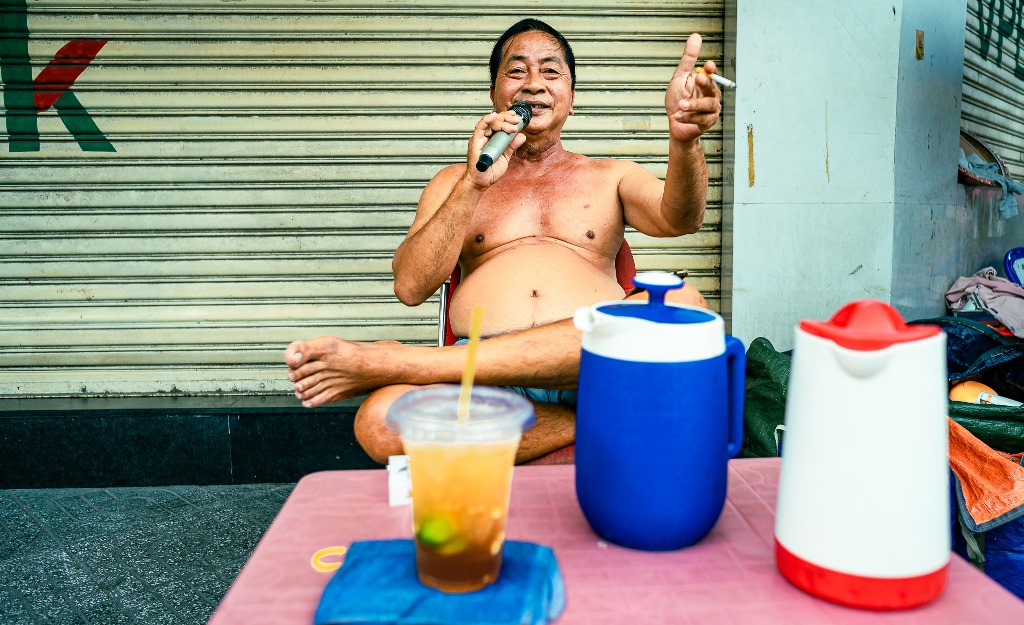
I’m pretty happy too, as it’s Sunday morning and I’m wandering aimlessly around the streets of Cholon, aka Saigon’s Chinatown. Whilst it’s unlikely that such a large, unruly, chaotic city as Saigon could ever be gentrified, it’s equally true that District 1, where most tourists stay and where you’ll find most tourist attractions, has had its rough edges smoothed off over the last decade or so. To discover the Saigon of old – the tiny alleyways, the markets, the incredible street food, the conical hats, the pavement barbers and coffee stalls, the boisterous locals – you need to escape D1 and dive into the outlying districts, and few are more fascinating than District 5, which encompasses the historic city of Cholon.
Originally settled in the 18th century by the persecuted Hoa people (Vietnamese of Han Chinese ancestry), Cholon (the name means Big Market) officially became a city in 1879 before merging with neighbouring Saigon in 1931. Yet despite having been absorbed for almost a century, Cholon has managed to retain a character all its own, and longer term residents of the city will always feel as if they’re crossing an invisible but very noticeable border when they travel from one to the other.
Most tourists who visit Cholon are Chinese or Taiwanese; the few westerners who venture here tend to stop at a couple of the more popular pagodas before heading back to D1. At Smiling Albino however, we like to go deep into a destination and spend our time exploring on foot, to really get a feel for the place. Coming into an area as fascinating and historic as this, and just hopping between a couple of pagodas by car, is a huge waste, and we’d argue that Cholon has as much to see – if not more – than its more famous neighbour.
Of course, like most visitors I start with two of the city’s most famous pagodas – Thien Hau and Quan Am. If you’re expecting the lavish golden temples of Thailand, Cambodia or Laos, then you couldn’t be more wrong: in this part of Vietnam, worshippers practice a very local form of Buddhism based mainly on Chinese traditions, rather than the Theravada form more common elsewhere in Southeast Asia, and this is reflected in the smaller, more simple nature of the pagodas.
Here in Thien Hau, unlike on the streets outside, peace and quiet reigns. Worshippers quietly light candles and wave incense, whilst picturesque incense coils hang from the ceiling. Interlopers such as I are made cautiously welcome, provided we don’t get in the way. Bored security guards (everywhere in Vietnam has at least one security guard, and they rarely have anything to do other than smoke endless Hero cigarettes) happily stop and chat or pose for photographs, delighted to meet a foreigner who speaks Vietnamese. You really don’t have to be remotely spiritual to enjoy the cool air, the smell of incense, and the respite from Cholon’s bustling streets.
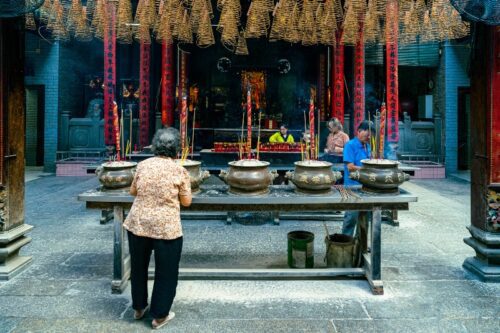
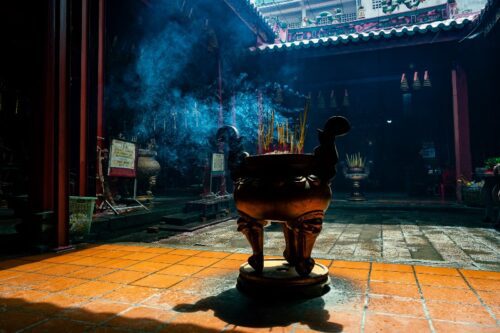
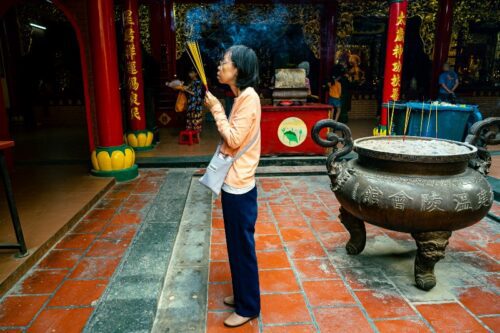
However, I’m not just here for the temples. Cholon is arguably the food capital of Saigon, and I’m hungry, and as I walk around the corner from Thien Hau, I’m immediately faced with a plethora of choices. I have three golden rules when eating in Vietnam. One, go to a joint that does one dish and one dish alone. Two, pick a restaurant where the boss is at least 60. And third, go where the Vietnamese go. I quickly spot a hu tieu noodle soup shop that is packed with locals, sells only different varieties of hu tieu, and whose owner, beckoning me in before I’ve even made up my mind, has clearly been doing this since I was in short trousers.
As usual, my golden rules do not let me down and the soup – rice noodles, various pig parts (including stomach), fresh herbs and a shrimp on top – is everything I’d hoped for and more. As fellow Vietnamophile Anthony Bourdain once said, “This is the way so many of the great meals of my life have been enjoyed. Sitting in the street, eating something out of a bowl that I’m not exactly sure what it is. And scooters going by. So delicious.”
Breakfast is followed as it always should be in Vietnam, by a cup of fiendishly strong local coffee, and I’m now ready to throw myself back into the fray by visiting the place from which Cholon gets its name – Binh Tay market, one of the biggest in the city. The market is mainly wholesale but, because of its stunning Chinese architecture, it attracts a lot of tourist visitors, though with the weekend I visit being a public holiday it’s a lot quieter than usual, with most of the stalls closed. On a busy day it’s chaos – prepare to be pushed, jostled and harangued (albeit goodnaturedly in most cases) if you’re there on a normal day.
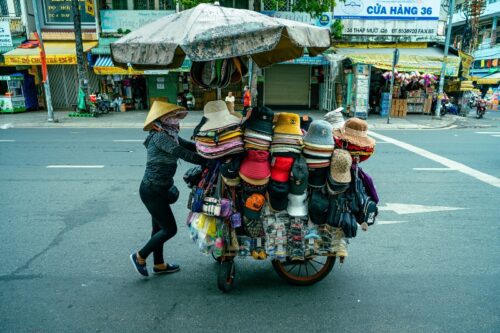
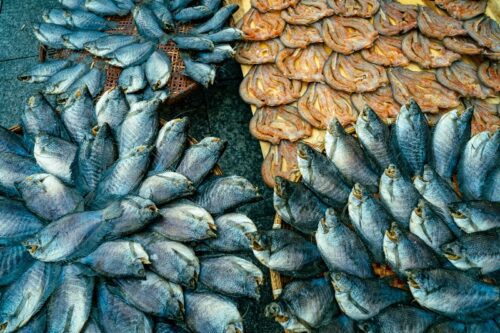
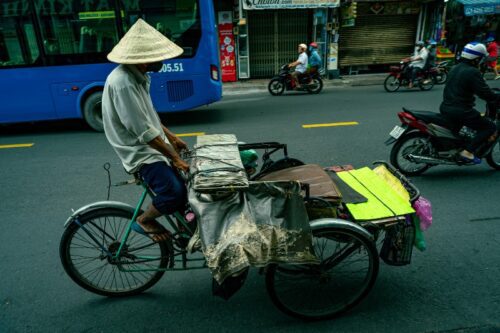
As I leave the market I encounter my karaoke-singing friend, politely refusing a swig of whatever concoction he’s currently drinking (I like a drink but at 9am?) and taking some photos of him before I really get into the meat & drink of Cholon – its back alleys. Saigon as a whole is extremely densely populated, with almost 4500 inhabitants per km2, and most of them live cheek-by-jowl in narrow alleyways, only accessible on foot or bike. You simply cannot understand the city without venturing into them – they’re perfectly safe, you’ll find hidden coffee shops, street food stalls, hairdressers and more, and pretty much everyone you meet will want to stop for a chat.
That’s certainly what happens to me as I wander Cholon’s back streets. I stop for another coffee next to a tiny neighbourhood pagoda; an old man invites me into his house for a cold drink; a salt trader insists on being photographed cradling a bag of his produce like a newborn infant; I have a long chat with an elderly cyclo driver who I interrupt reading the newspaper; a security guard at a pagoda sports an increasingly rare example of the lucky hairy mole. Such are the benefits of getting off the tourist trail, getting lost, and wandering around smiling at everyone.
Late in the morning the sky darkens, and I just have enough time to explore Luong Nhu Hoc street, aka lantern street, a mecca for locals during festivals when every shop sells colourful lanterns and other goods, quiet but still colourful on this grey Sunday morning. The heavens open, and I seek shelter in the nearest doorway, which thankfully turns out to be an excellent Chinese restaurant. I enjoy the best roast pork I’ve had in a long time, with some rice cooked in chicken stock and a cold beer, for around $6. Cholon does not give up its charms easily, but armed with a map (or a local expert) and a smile, it’s an absolute joy to visit.
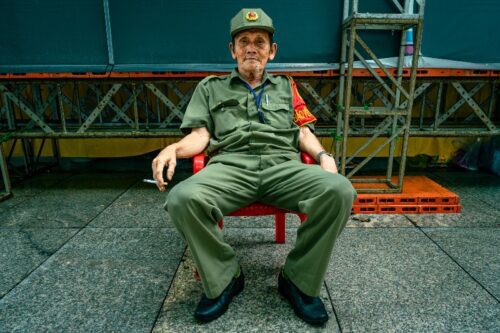
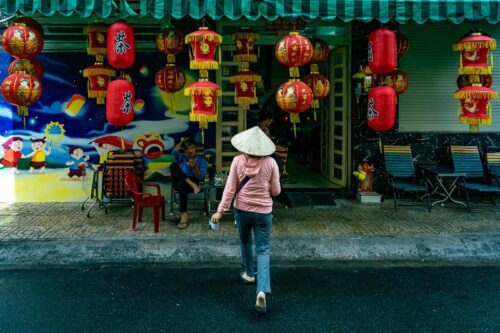
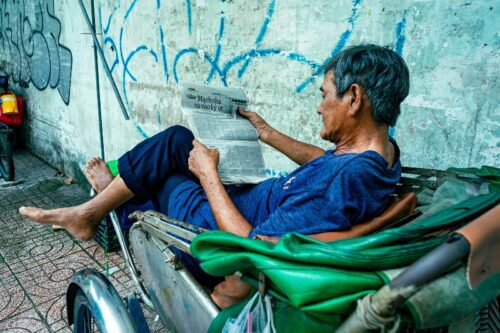
Want to follow in our footsteps and get an insider’s view of Cholon? Contact us!
